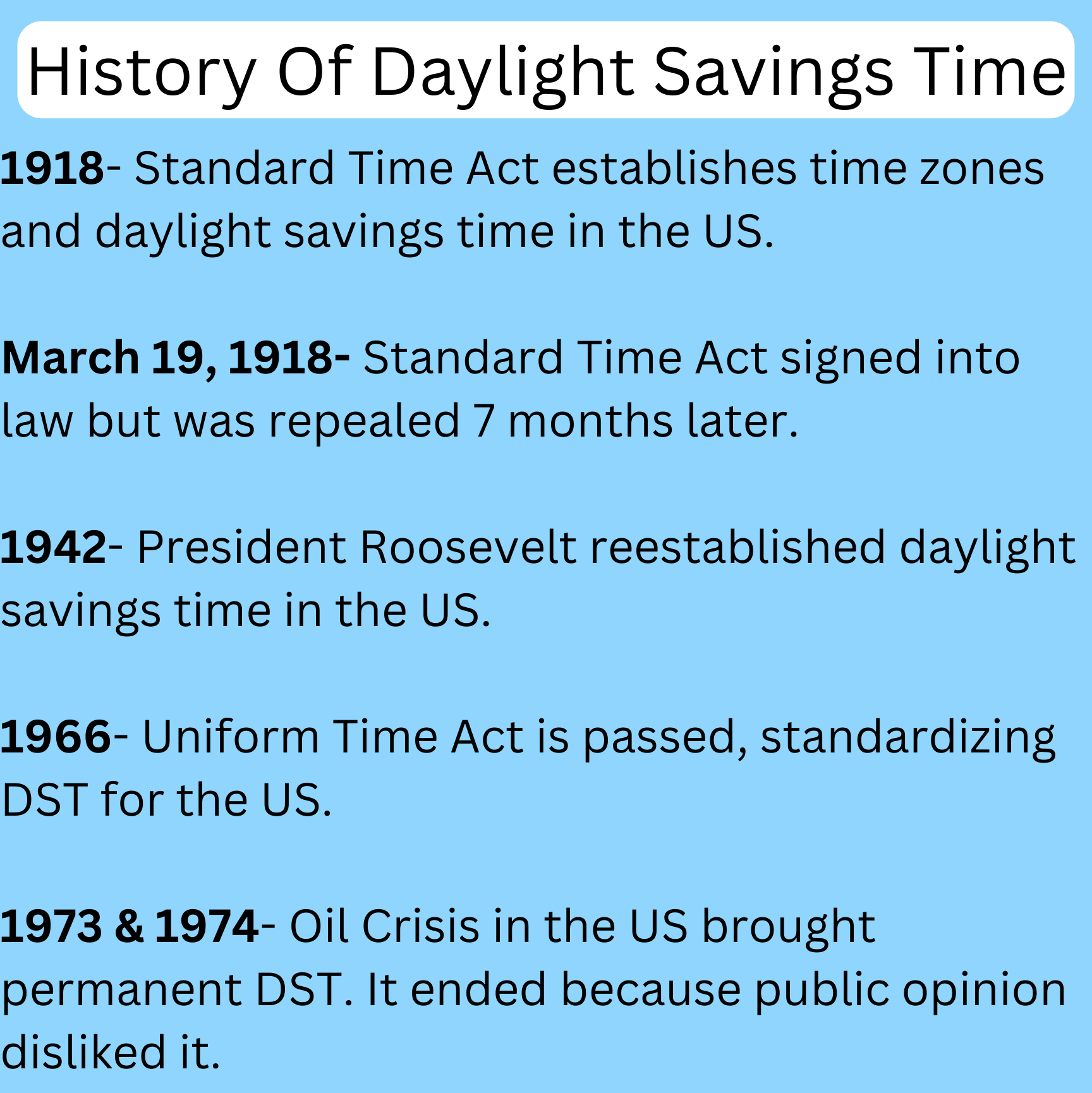Daylight savings time (DST) advances the clocks by an hour during warmer months (March to November) so that it gets darker later in the evening. The purpose of doing this is so people can make more use of daylight. Although, many Americans dread changing the clocks. DST starts on the second Sunday in March and ends on the first Sunday in November. This year DST ends on Sunday, November 5. After we change the clocks in November, we practice standard time until we change the clocks again in March.
During World War I, to increase efficiency and decrease energy consumption, DST was introduced to the U.S. Congress. It was first introduced under the Standard Time Act in 1918. This bill established that standard time would be divided into five time zones (Eastern, Central, Mountain, Pacific, and Alaskan) and implemented that on the last Sunday of March, the clocks advance one hour, and on the last Sunday of October, the clocks return back one hour. The bill was signed into law on March 19, 1918, by President Woodrow Wilson. This bill lasted 7 months but was then repealed.
In 1942, DST was reestablished during World War II. With this came a lot of chaos across the country. Because of the chaos, the Uniform Time Act was passed in 1966. This established switching between standard time and DST.

Years later in 1973 to 1974, there was an oil crisis. Federal Reserve History says this, “began a series of production cuts that altered the world price of oil. These cuts nearly quadrupled the price of oil from $2.90 a barrel before the embargo to $11.65 a barrel.” The embargo was lifted in March of 1974, but the high prices remained. This oil crisis brought permanent daylight savings time to the U.S. Permanent DST or year round DST added an extra hour of sunlight in the evenings all year round. So if we were to implement this again, the clocks would be moved forward an hour and stay that way. This did not last very long because public opinion disliked the darker mornings in the winter.
Although permanent DST was frowned upon in 1974, it could make a comeback in the future—thanks to the Sunshine Protection Act. The Sunshine Protection Act would implement permanent daylight savings time. We would eliminate standard time (November through March) and have DST year round.
This bill has been introduced each year since 2018 by Senator Marco Rubio from Florida. Representative Vern Buchanan from Florida has also introduced this bill in the House of Representatives. In March of 2022 the bill passed the senate through unanimous consent. In order for the bill to become a law, it needs to pass through the House of Representatives and then be signed into law by the president.
Although most of the U.S. still changes the clocks, a few states and territories have stopped. Currently, Hawaii, Arizona, American Samoa territories, Guam, Northern Mariana Islands, Puerto Rico, and U.S. Virgin Islands have standardized DST.
If this bill would become a law, it would have numerous benefits. According to Vern Buchanan’s website, these advantages include: reducing car accidents, reducing risk for cardiac issues, strokes, and seasonal depression, reducing crimes committed, benefiting the economy, reducing obesity and increasing physical fitness, benefiting agriculture, and reducing energy usage.
Car accidents would decrease because daytime hours would better align with work hours and less people would have to drive in the dark. According to The Purdue Exponent, “Night driving is nine times more lethal than daytime driving” With people having to drive in the dark just to complete their daily activities, having that extra hour of light would be beneficial.
Permanent DST will also promote better health, reducing risk for cardiac issues, strokes, and seasonal depression. UT Southwestern Medical Center shows that after the start of daylight savings time, their is a “small increase in heart attacks” and “stroke rates are 8% higher in the first two days following both time changes” In addition, when the clocks change it disrupts sleep schedules and people don’t have as much exposure to sunlight, lowering vitamin D levels which lowers mood and increases depression.
Crimes are more likely to take place at night with it being dark. The Stanford Institute for Economic Policy Research found, “robbery rates decrease by an average of 51% during the hour of sunset following the shift to DST in the spring.” This decrease is because of the extra light. Just giving Americans back one hour would increase their safety and decrease criminal activity.
When DST ends and we transfer to standard time, economic activity decreases. If it gets darker earlier people are less willing to go out at night to shop, eat, etc. Darkness limits so many activities for Americans, such as: sports, going out, going on walks, and more. When it stays lighter out for the extra hour, Marketplace says, “businesses have the advantage of seeing increased purchasing activity” Extra light equals, more people spending more money.
Permanent DST will also reduce childhood obesity and increase physical fitness. During DST children are more physically active. The Columbia Tribune reported a, “study found that kids had 15 to 20% greater activity in a day where the sun set after 9:00 p.m. compared to a sunset of 5:00 p.m.” Research has also shown that adults tend to be more active as well. With, “pedestrian activity [increasing] by 62% and cyclists activity by 38% because of additional daylight.” These increased activity levels will lower childhood obesity, improving Americans overall health.
Permanent daylight savings time will benefit agriculture, especially benefiting dairy farms. Ag America says, “moving the clock back an hour in the fall actually moves [cows] milking time back an hour, and livestock cannot understand waiting another hour to be milked. Then, just as the cows get used to it, the milking schedule gets changed again in the spring.” Personally, I can relate to this. I live on a dairy farm and twice a year when the time changes, the cows have more or less milk to harvest at milking time because they have to adjust their bodies and their production to the new time schedule. Cows get used to their schedules and know when it’s time to be milked, so changing their schedule is not good for milk production.
Lastly, DST reduces energy usage. The Department of Energy reports that electricity savings were, “0.5 percent per each day of Extended Daylight Saving Time” These energy use reductions are very slight, but there still is a decrease during DST.
There are a few things that could be considered as a benefit for adopting permanent standard time instead of permanent DST. According to the American Academy of Sleep Medicine these are:
- The standard time clock matches our body’s internal clock. When it is lighter in the mornings and darker in the evenings, our bodies and nature are better aligned.
- More sunlight in the morning promotes our safety. With there being more sunlight in the mornings, it makes it safer for Americans to be traveling early in the morning to work, school, etc.
- Permanent DST would be a disadvantage for northern states such as Montana, North Dakota, and Michigan because their sunrise wouldn’t occur until after 9:30 a.m. in the winter. The sunrise would also be later in other parts of the country as well, such as New York City, Los Angeles, and Minneapolis.
- Permanent DST was chaotic when the U.S. tried it before. In 1973, the U.S. implemented permanent DST and it was chaotic. Public opinion was very against it so the U.S. returned back to standard time.
Although there are disadvantages to permanent DST and advantages to implementing permanent standard time instead, the advantages to permanent DST outweigh the disadvantages.
Every American is going to have their own opinions on the subject. Maybe permanent daylight savings time is the best option, maybe not; only time will tell.





